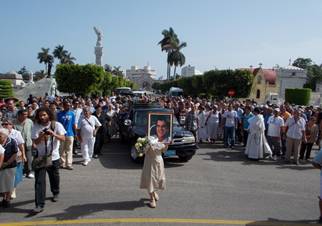
The truth about the accident in which Payá Sardinas died has been the subject of various speculations. The source of these is absolutely the responsibility of the Cuban authorities who, from the very beginning, tried to play down the importance of it, presenting it as a simple traffic accident, one more of the many that occur in the country, forgetting that, because of who the main victim was, it would be important, both inside and outside Cuba. Used to avoiding political opponents, under the absurd view that, as long as they don’t talk about them they don”t exist, were wrong again: definitely, they are experts at tripping over the stones.
The first thing I noticed was, precisely, the brief information about the event that appeared on page 6 of the newspaper Granma on Monday, July 23, as if it would pass unnoticed in a country where the death of any citizen politically close to the regime is trumpeted in the headlines, with a grief-filled farewell, the funeral, the special wreath and even what speaker is appointed, depending on the origin and importance of the person: artist, athlete, scientific, historical, and so on.
The second was the planned repression at the exit of the parish of St. Saviour of the World, in the Cerro neighborhood (where Payá lived), to prevent the procession from marching on foot to the nearby Colon Cemetery. Despite this, the funeral was crowded, which is verifiable in the photos posted on the Internet, absent, as is usual, from the official media.
Thirdly, the exhaustive official report, with testimony from eyewitnesses and experts with years of experience, trying to prove that the path was correctly marked, and that full responsibility lay with the driver (the Spanish citizen Carromero, injured in the accident ), for not paying attention, speeding and not maneuvering the danger properly, violating several articles of the brand new Highway Safety Code, because of which he will be prosecuted under Cuban law.
Fourthly, the controlled press conference of the Swedish citizen Aron Modig (also injured in the accident), presented on the Roundtable TV program on the Cubavision Channel, in which, instead of focusing on clarifying the accident, they tried to give it a political connotation, seeking to demonstrate that both the deceased and the injured were conducting destabilizing activities against the government, with possible legal implications for foreign nationals and, incidentally, to throw some discredit on the figure of Payá.
Yesterday the same television channel broadcast material on Carromero, and today appearing in the newspaper Juventud Rebelde was a commissioned article talking about violations of traffic laws committed by him in Spain. It seems that the chosen scapegoat for the new telenovela — the soap opera — broadcast in the same style as that of Alan Gross, is Carromero.
It makes sense: he belongs to and is a leader of the People’s Party youth organization, which currently governs in Spain, which is not close to the Cuban government. As usual, the authorities seek to punish him as an example, in order to keep it as a bargaining chip to use now or at any other appropriate time. My friend Cheo, who is always up-to-date, said to me: it was served to them on a silver platter.
It is true that the times are not the same, although some people do not think this is the case, nor are the characters so alike, but they are quite similar. There should be at least a little more than political pragmatism when dealing with the case and the overreaction and desire to always play the role of the eternal victim and reap the maximum gain — on the part of the authorities — should be left aside.
However, these missteps by the authorities, caused by the syndrome of secrecy (criticized from the platform but applied in practice), and their political blindness that prevents them from seeing the changing reality of the country, are intended to obviate or accommodate their survival needs, instead of giving them greater credibility.
August 4 2012
